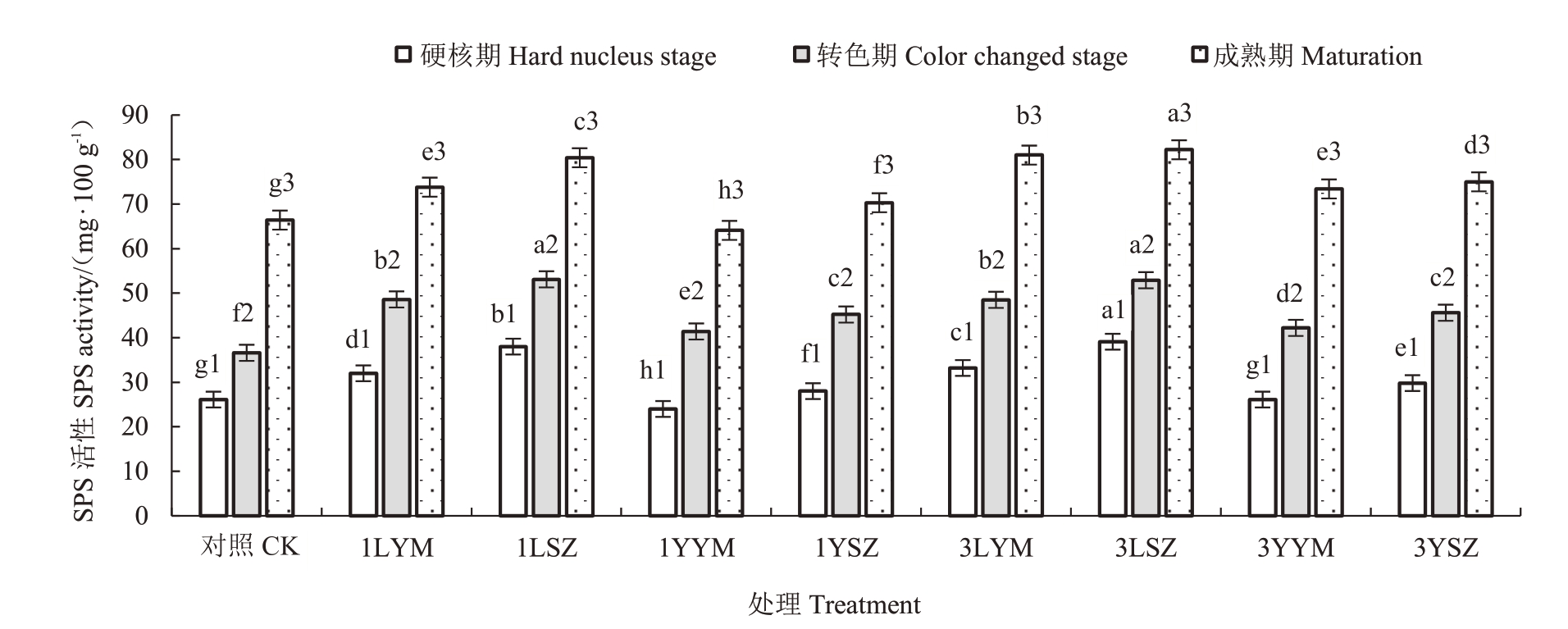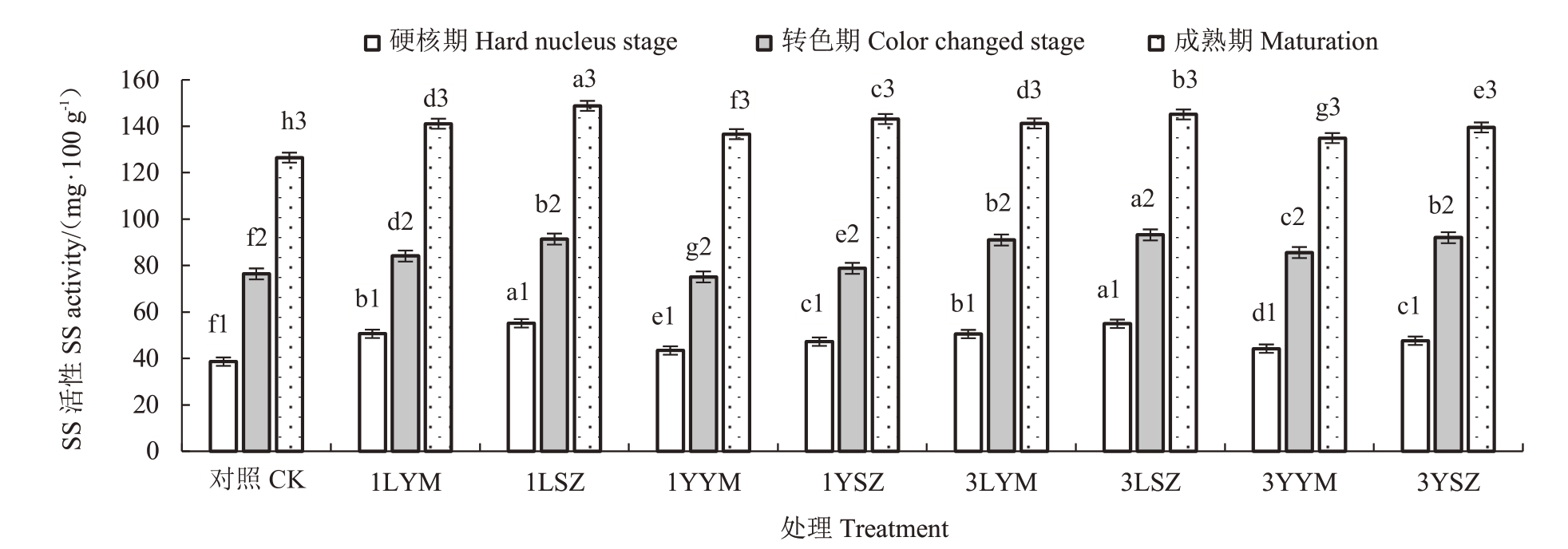杨梅(Myrica rubra Sieb Zucc.)为杨梅科杨梅属常绿果树,光合速率日变化规律受栽培环境影响,具有“单峰”和“双峰”两种现象,光补偿点在25~53 µmol·m- 2·s- 1 之 间,光 饱 和 点 在335.05~700.09 µmol·m-2·s-1之间,具有阳性植物的特性[1-3]。浙江省杨梅在采收期易遭遇持续雨水天气造成丰产不丰收,设施栽培可调控环境因子,减少病虫害发生,在高温多雨的江浙地区,能显著提高果实品质,增加商品果率[4],近年来设施栽培杨梅发展势头迅猛。设施栽培改变杨梅的光合特性[5],成熟期大棚内杨梅果实品质比棚外优良,但是由于转色期至成熟期间棚内的光照不足,需要人工补光,提高设施栽培杨梅果实的综合品质[6],关于杨梅的补光研究尚未见报道。
光质是植物生长发育的重要影响因子之一,能调节形态建成、生理代谢、营养品质等[7]。随着设施园艺的不断发展,光质调控在设施栽培中用于促进作物生长和改善农产品品质,应用日益广泛,如不同颜色光质可显著改善番茄幼苗生长,提高番茄产量[8-9],蓝光显著增加柑橘维生素C 和类胡萝卜素含量[10-11]。LED植物生长灯红蓝(7∶2)补光3 h,冬季日光温室西葫芦的果实品质得到显著改善,维生素C含量、可溶性蛋白含量和糖酸比显著增加[12]。LED混合光源绿光∶蓝光∶红光=1∶1∶3 处理可以增加日光温室微型薯生产的数量和质量[13],LED 红光促进青花菜和树莓中萝卜硫素、维生素C、总酚等活性物质积累[14-15],LED 补充光源能够显著提高水稻和麦草内源激素含量、抗氧化酶活性、可溶性蛋白和丙二醛含量,提高产量和抗逆性[16-17],红光与白光对火龙果茎的叶绿素、内源激素含量及开花数、果实产量有较明显的促进效果[18],运用不同颜色透光膜可以提高杨梅果实品质,改变杨梅果实成熟期[19-20]。由于不同的植物对不同照明系统有不同的反应,所以为特定作物量身定制照明系统非常重要[21],开发针对设施杨梅的补光系统是产业的迫切需求,有望通过补光的技术措施提高设施栽培杨梅果实的综合品质。
笔者在本研究中选择不同红蓝光比例的LED灯、荧光灯,观测补光对杨梅硬核期、转色期和成熟期的树体营养生长和果实发育的影响,为开发设施栽培杨梅补光技术提供理论指导。
1 材料和方法
1.1 试验材料
试验于2018 年5—6 月在浙江省兰溪市马涧镇杨梅园进行。供试品种为健康的16 年生连栋大棚设施栽培东魁杨梅。杨梅园土壤为酸性黄壤,pH 4.25,有机质含量(w,后同)12.53 g·kg-1,全氮含量0.71 g·kg-1,水解氮含量37.25 mg·kg-1,有效磷含量2.14 mg·kg-1,速效钾含量178.67 mg·kg-1。施肥施药等按常规管理。
光源采用4 种不同红蓝光比例的补光灯类型(图1):全光谱LED育苗灯(50 W,RB 2∶1,LYM)和全光谱LED 生长灯(50 W,RB 5∶1,LSZ)、荧光育苗灯(60 W,RB 1∶4,YYM)和荧光生长灯(60 W,RB 1.2∶1,YSZ),均从上海合鸣照明电器有限公司采购,以不补光为对照(CK)。不同的灯分别设计1盏和3盏两个补光剂量,1 盏灯悬挂在树体冠幅中心点垂直上方1 m 水平位置;3 盏灯的悬挂方法如下,以树冠滴水线垂直上方1 m 水平位置圆圈的1/3 周长处为端点进行两点连线,3条连线中间位置分别悬挂1盏灯,每株树共悬挂3 盏灯,3 盏灯之间的距离相等。每个补光处理随机选择3株树,每株树算1个重复,每处理共3 次重复,不同重复树体间距5 m 以上。补光从杨梅果实硬核期开始,到杨梅果实成熟结束,每天补光时间从5:00—19:00。

图1 补光设置
Fig.1 Schematic diagram of setting of light supplementation
1.2 测定方法
取各处理植株的东、南、西、北4个方向春梢各5支,共20支,用直尺测量春梢长度,用数显游标卡尺(上海刀具厂)测量当年生春梢基部直径,取平均植,每支算1次重复。选取树体外围中部位置营养枝顶端以下第4~8 枚成熟叶片进行测定和取样,每个测量指标取30 枚叶片检测并且取平均植,用SPAD-502 PLus 叶绿素计(日本美能达公司)离体测定SPAD 植,测量叶片长度(叶片顶端至基部最长距离,不包括叶柄)、宽度(叶片中间最宽距离),叶片厚度用数显游标卡尺测量,先测定10枚叶片的厚度,3次重复,取10枚叶片厚度的平均植。
果实自然成熟时于东、西、南、北、中5个方位分别在树冠的中部各采取果实40个,之后检测包括颜色以及可溶性固形物、总糖、可滴定酸、维生素C 含量等品质参数指标。用手持糖度计(Pocket refractometer pal-1)测定可溶性固形物含量百分比。采用色差自动检测计进行色差程度的检测,测定每个果实处于赤道部位环4个方向的L(光泽明度)、a(红色饱和度)和b(黄色饱和度),取平均植。采用蒽酮比色法测定总糖含量,采用酸碱滴定法测定可滴定酸含量,采用2-6 二氯靛酚滴定法测定维生素C 含量[22]。糖酸比用总糖含量与可滴定酸含量的比植表示。果实的蔗糖磷酸合成酶(SPS)、蔗糖合成酶(SS)的提取和活性测定参考凌丹丹等[23]的方法。
1.3 数据统计分析
采用Excel 2010作数据初步处理,基于DPS15.0软件采用Duncan’s 新复极差法进行显著性检验(p <0.05)。
2 结果与分析
2.1 不同补光处理对叶和新梢特性的影响
所有补光处理对杨梅的叶长、叶宽、叶厚和梢长均有较好的促进作用。显著促进叶长、叶宽和叶厚的生长,促进效果分别在6.91%~18.91%、6.16%~18.47%和4.01%~24.56%之间,除悬挂1 盏全光谱LED 育苗灯(1LYM)处理和悬挂1 盏荧光育苗灯(1YYM)处理外的叶长、除1LYM 外的叶宽以及除悬挂1 盏荧光生长灯(1YSZ)、悬挂3 盏全光谱LED育苗灯(3LYM)和悬挂3盏荧光生长灯(3YSZ)处理外的叶片厚度,其他补光处理的促进作用均达到显著水平(表1)。对枝梢长度也有显著的促进作用,促进效果为16.35%~64.53%,均达到显著水平。总体来说,对叶长、叶宽、叶厚和枝梢长度4 个参数促进作用均较好的是悬挂1 盏全光谱LED 生长灯(1LSZ)、1YYM、1YSZ 及悬挂3 盏全光谱LED 生长灯(3LSZ)和3YYM。但是所有补光处理对枝梢粗度和叶绿素含量影响不显著。这说明,所有补光处理均能较好地改善大棚杨梅的叶片和新梢的生长。
表1 不同补光处理对设施栽培杨梅营养生长的影响
Table 1 The vegetative growth of facility cultivation of bayberry under different light supplemental treatments

注:1LYM、1LSZ、1YYM、1YSZ 表示每株树悬挂了1 盏灯;3LYM、3YYM、3YSZ、3LSZ 表示每株树悬挂了3 盏灯。LYM.全光谱LED(50 W)育苗灯;LSZ.全光谱LED(50 W)生长灯;YYM.荧光育苗灯(60 W);YSZ.荧光(60 W)生长灯;CK.不补光对照。同一列数据后不同小写字母表示差异显著(p <0.05)。下同。
Note:1LYM,1LSZ,1YYM,1YSZ means 1 lamp installed on each tree;3LYM,3YYM,3YSZ,3LSZ means 3 lamps installed on each tree.LYM.Full spectrum LED(50 W)seedling lamp;LSZ.Full spectrum LED(50 W)growth lamp;YYM.Fluorescent seedling lamp(60 W);YSZ.Fluorescent(60 W)growth lamp;CK.No light supplement control.The lowercase letters indicate significant difference in the same column(p <0.05),and different letters indicate significant difference.The same below.
处理Treatment 1LYM 1LSZ 1YYM 1YSZ 3LYM 3LSZ 3YYM 3YSZ对照CK叶绿素(SPAD)Chlorophyll 44.47±0.60 a 43.82±0.48 ab 42.73±0.44 b 43.78±0.45 ab 43.73±0.27 ab 42.87±0.35 b 43.01±0.12 ab 44.50±0.36 a 43.37±0.66 ab叶片长度Leaf length/mm 104.47±2.53 c 114.61±5.84 a 106.04±1.29 c 108.60±2.23 b 111.21±9.07 ab 111.85±4.00 ab 111.47±7.35 ab 116.20±1.14 a 97.72±2.52 c叶片宽度Leaf width/mm 30.52±1.56 c 33.08±1.01 ab 32.22±0.60 b 33.06±1.02 ab 33.78±2.04 a 32.32±1.47 ab 34.06±1.76 a 33.41±0.43 a 28.75±1.04 c叶片厚度Leaf thickness/mm 4.62±0.24 b 4.69±0.36 b 4.73±0.23 b 4.33±0.04 c 4.15±0.19 c 4.97±0.35 a 4.84±0.42 a 4.18±0.19 c 3.99±0.09 c枝梢长度Twig length/mm 62.82±3.67 c 75.38±3.11 b 76.67±4.14 b 79.17±2.80 b 65.61±4.33 c 88.83±4.74 a 79.27±9.09 b 63.58±2.90 c 53.99±1.91 d枝梢粗度Twig width/mm 2.67±0.09 ab 2.59±0.10 b 2.85±0.06 a 2.70±0.07 ab 2.59±0.05 b 2.68±0.01 ab 2.84±0.10 ab 2.59±0.01 b 2.70±0.08 ab
2.2 不同补光处理对果实发育和品质的影响
2.2.1 对单果质量和果色的影响 不同的补光处理对果实大小发育和着色有一定的影响。除1YSZ处理外,1盏灯的处理总体表现为促进果实发育,在硬核期、转色期和成熟期比对照增加3.64%~29.92%,其中1LYM 处理的果实在成熟期单果质量增加最大。与对照相比,3 盏灯的处理对果实发育影响不显著或者有一定的抑制作用,其中3LSZ和3YSZ在3 个时期均表现出抑制作用,至成熟期单果质量比对照低6.84%和15.13%。1YYM 增加了果实亮度,L 植增大23.72%,3YYM 和3YSZ 使a 植显著增大,果实比对照偏红色,1LSZ、1YYM、1YSZ、3LYM、3LSZ使a植显著减小,果实比对照偏绿色,1LYM与对照差异不显著。所有处理只有1YSZ 使b 植为正植,果实与对照相比偏黄色,其他处理和对照b植均为负植,说明这些补光处理对b植改善效果不佳(表2)。从综合促进果实发育和改善亮度颜色的效果来看,1YYM最好,1LSZ和1LYM次之。
表2 不同补光处理对设施栽培杨梅单果质量和果色的影响
Table 2 The fruit weight and color changes of bayberry in facility cultivation under different light supplemental treatments

处理Treatment L a b 1LYM 1LSZ 1YYM 1YSZ 3LYM 3LSZ 3YYM 3YSZ对照CK单果质量Single fruit weight/g硬核期Hard nucleus stage 12.03±0.05 a 12.82±0.10 a 13.07±0.07 a 11.31±0.17 b 11.95±0.04 a 10.67±0.10 c 12.21±0.17 a 10.73±0.30 c 12.37±0.09 a转色期Color changed stage 21.69±0.17 a 20.54±0.09 b 20.61±0.27 b 18.13±0.50 c 18.26±0.31 c 16.57±0.39 d 18.05±0.16 c 15.61±0.11 e 18.25±0.31 c成熟期Maturation 31.35±0.34 a 28.26±0.28 b 28.14±0.48 b 24.94±1.12 c 24.56±0.58 c 22.48±0.70 d 23.90±0.29 c 20.48±0.07 e 24.13±0.56 c Color L 30.09±0.67 b 34.83±0.54 b 40.89±0.56 a 34.85±1.97 b 34.67±2.44 b 34.83±0.54 b 30.65±2.37 b 34.31±0.95 b 33.05±1.29 b Color a 12.30±3.58 b 7.59±11.25 c-24.15±23.65 e 1.87±13.53 d-1.88±18.73 d-21.29±16.25 e 16.74±3.69 a 19.69±19.88 a 11.19±11.09 b Color b-168.64±67.38 e-176.58±114.05 e-48.95±56.11 b 35.20±135.96 a-49.35±78.61 b-160.52±55.93 e-206.07±130.16 f-80.16±60.38 c-112.78±29.59 d
2.2.2 对成熟果实可溶性固形物、总糖、可滴定酸及维C含量的影响 各补光处理均对杨梅果实品质有一定的改善作用(表3)。可溶性固形物含量除3LYM 外,其余处理的均略有增加,在1.52%~5.64%之间;总糖含量除1YSZ 和3LYM 外,其余处理的总糖含量略有增加,增加0.09%~7.66%。可滴定酸含量除1YYM降酸效果较弱、降低3.64%外,其余处理降酸效果均显著,降低11.52%~30.91%。除1YYM的糖酸比略有增加(增加3.90%)外,其余处理的糖酸比均显著增加,在17.82%~55.88%之间,无论是LED灯还是荧光灯,生长灯处理的糖酸比大于育苗灯处理,除LSZ外同类型3盏灯的效果优于1盏灯。所有补光处理维生素C含量显著增加,增加13.01%~34.79%,其中1LYM、1LSZ、1YSZ、3YYM增加最多。这说明,综合糖酸比和维生素C含量增加情况,1LSZ对果实品质的改良作用最好,1LYM作用次之。
表3 成熟期杨梅果实可溶性固形物、总糖、可滴定酸、维生素C 含量及糖酸比
Table 3 The contents of soluble solids,total sugars,titratable acids,vitamin C and sugar-acid ratio in ripen bayberry fruit

处理Treatment 1LYM 1LSZ 1YYM 1YSZ 3LYM 3LSZ 3YYM 3YSZ对照CK w(可溶性固形物)Soluble solids/%14.17±0.41 ab 14.05±0.24 ab 14.21±0.31 ab 14.31±0.18 ab 13.74±0.19 b 14.62±0.24 a 14.34±0.12 ab 14.38±0.05 ab 13.84±0.24 ab w(总糖)Total sugar/%12.39±0.25 a 12.51±0.30 a 11.63±0.57 a 11.52±0.97 a 11.37±0.32 a 11.71±1.04 a 12.11±0.11 a 12.09±0.08 a 11.62±0.17 a w(可滴定酸)Titratable acid/%1.46±0.06 b 1.14±0.11 c 1.59±0.16 ab 1.27±0.06 c 1.33±0.11 c 1.27±0.06 c 1.46±0.06 b 1.14±0.11 c 1.65±0.12 a糖酸比Sugar acid ratio 8.49 10.97 7.31 9.07 8.55 9.22 8.29 10.61 7.04 w(维生素C)Vitamin C content/(mg·100 g-1)10.15±0.65 b 10.15±0.86 a 9.50±0.86 a 10.15±0.86 a 8.51±0.32 b 10.48±0.32 a 10.15±0.32 a 9.83±0.56 b 7.53±1.42 c
2.3 不同补光处理对果实发育过程中糖代谢相关酶活性的影响
2.3.1 对蔗糖磷酸合成酶(SPS)活性的影响 各补光处理均显著改变了蔗糖磷酸合成酶活性。在同一个时间内,无论是LED 灯还是荧光灯,生长灯促进蔗糖磷酸合成酶活性的效果均优于育苗灯,同类型3盏灯的效果优于1盏灯,这与成熟期果实糖酸比的规律基本一致。除1YYM 在硬核期和成熟期杨梅果实的蔗糖磷酸合成酶活性显著降低、3YYM 在硬核期没有显著变化外,其余所有补光处理在硬核期、转色期和成熟期共3个时期中蔗糖磷酸合成酶活性均显著增加,在7.28%~49.81%之间,1LSZ、3LSZ 的蔗糖磷酸合成酶活性增加最多,在21.08%~49.81%之间,而且硬核期增加最显著(图2)。这说明红光占比大的LED 类生长灯的补光利于杨梅果实的成熟和糖分的积累,LED生长灯补光效果优于荧光生长灯。

图2 补光处理下杨梅果实蔗糖磷酸合成酶(SPS)活性变化
Fig.2 The changes in sucrose phosphate synthase(SPS)activity of bayberry fruit under different light quality and light intensity
柱子上字母后数字1、2、3 分别代表在硬核期、转色期和成熟期,不同小写字母代表差异显著(p <0.05)。下同。
Letters with the number 1, 2, 3 on the columns represent the hard nucleus stage, color changed stage and mature stage respectively, and different small letters represent significant difference(p <0.05).The same below.
2.3.2 对蔗糖合成酶(SS)活性的影响 各补光处理均显著改变了蔗糖合成酶活性。在同一个时间内,无论是LED 灯还是荧光灯,生长灯促进蔗糖合成酶活性的效果优于育苗灯,但是同类型3 盏灯的效果与1 盏灯相比有好有差,这也与成熟期果实糖酸比的规律基本一致。除1YYM 在转色期杨梅果实的蔗糖合成酶活性显著降低,其余所有补光处理在硬核期、转色期和成熟期中蔗糖合成酶活性均显著增加,在3.14%~42.75%。其中,与促进蔗糖磷酸合成酶的活性效果相似,1LSZ、3LSZ的蔗糖合成酶活性增加最多,在14.70%~42.75%之间,而且硬核期增加最显著(图3)。这说明红光占比大的LED生长灯的补光利于杨梅果实的成熟和糖分的积累,LED生长灯补光效果优于荧光生长灯。

图3 补光处理下杨梅果实蔗糖合成酶(SS)活性变化
Fig.3 The changes in sucrose synthase(SS)activity of bayberry fruit under different light quality and light intensity
3 讨 论
不同光质处理能引起植物发生形态和生理变化,营养生长能直观反映植物生长[24-25]。番茄苗期照射红光或蓝光可促进番茄幼苗的生长,有利于培育壮苗,蓝光处理幼苗花期提早,产量显著提高[8, 21]。本研究结果与其一致,经LED 生长灯(RB 5∶1,LSZ)处理后,杨梅叶长、叶宽、叶片厚度和梢长均显著高于对照,说明随着红蓝组合LED光源中红光比例的增加,植株的营养生长会更旺盛。但张晶等[26]研究经LED 植物生长灯(RB 5∶1)处理后草莓的株高、叶片数、叶柄长等都有显著降低,与本文研究结果不同,这可能与不同的植物对光的利用效能不同相关。本研究所有补光处理对叶绿素含量没有显著性影响,这与前人研究一致,红蓝光对生菜的叶绿素含量也没有显著影响[27]。白蓝光组合补光的大葱光合电子传递效率和叶绿体超微结构完整性方面均有显著提高和改善[25],比白-绿组合和白-黄组合效果更好,这说明补光改变植物营养生长的机制复杂,植得深入研究。
补光能提高作物产量,提高果实品质,如补光提高甜椒产量、改善果实品质[28]。红蓝(3∶1)组合光和红色光质处理下番茄红色素含量与对照相比有明显升高[29-30],提高茄子产量[31],红蓝光显著增加马铃薯块茎质量和葡萄单果粒质量[13, 32]。本研究中,经1LSZ、1YYM处理后,杨梅果实发育加快,单果质量增大,这与前人的研究一致[28-32]。红蓝光处理葡萄的总糖含量略高于对照[32],本研究中生长灯处理的杨梅果实可溶性固形物、总糖含量略有增加,这与前人研究结果基本一致[32]。但是红蓝补光对葡萄的降酸效果不明显[32],这与本文结果不一致,本研究中所有补光处理酸含量明显下降,这可能是因为葡萄和杨梅果实酸的降解过程有差异。红蓝光处理的西葫芦和生菜维生素C 含量显著增加[12,27],本文研究结果与前人研究结果一致,这说明红蓝补光对杨梅果实的营养价植和风味提升有促进作用。紫外光、蓝光和红蓝光3种光质补光处理均增加了葡萄果实中醛酮类物质的种类及含量[32],蓝光能增加柑橘的抗坏血酸和类胡萝卜素的含量[10-11],LED 灯红蓝白光组合处理后可提高茄子、香蕉和树莓的抗坏血酸、总酚、可溶性糖、游离氨基酸、可溶性蛋白含量[15,33-34],红蓝光处理的甜瓜果实糖和酯类香气物质含量较高[35]。蓝色≥50%的双色光能保证麦草产量,提高胡萝卜素含量,降低过氧化氢(H2O2)和丙二醛(MDA)含量,麦草抗逆潜力增大[17]。笔者在本研究中未就杨梅总酚、酯类、H2O2和MDA 等物质进行检测,杨梅是总黄酮类物质含量较高的水果,补光处理也可能对杨梅的次生代谢和抗逆物质具有较大的影响,这植得后期深入研究。
蔗糖是成熟果实中的主要糖分,SPS和SS是参与蔗糖合成的关键酶,不同光质处理下植物中的碳水化合物含量的变化会受到这些相关酶活性的调控,较高的酶活性意味着有利于光合作用产物向蔗糖的转化。凌丹丹等[23]研究番茄叶片的蔗糖合成酶(SS)的活性在白红蓝光处理下最高,本研究中在果实的3 个生长时期内,所有补光处理均显著促进SPS活性和SS活性,这与本文研究结果相一致。本研究中SPS 活性和SS 活性增加规律与成熟期果实总糖含量的规律略有差异,但是与糖酸比一致,这很可能是SPS 活性和SS 活性变化影响到可滴定酸相关酶活性,补光处理对可滴定酸降解的影响植得深入研究。
总之,在设施杨梅栽培上开发系统的补光技术,促进杨梅的营养生长,增强树体抗逆性,增加单果质量,改善果实品质,提升果品风味,是植得深入研究和推广的现代产业技术。
4 结 论
所有补光处理对杨梅的叶长、叶宽、叶厚和梢长均有较好的促进作用。1盏灯的处理总体表现为促进果实发育,在硬核期、转色期和成熟期单果质量比对照增加3.64%~29.92%,其中1LYM的成熟期单果质量增加最大,3 盏灯的处理对果实发育影响不显著或者有一定的抑制作用。各处理显著降低果实可滴定酸含量3.64%~30.91%,显著增加糖酸比和维生素C 含量,分别增加3.90%~55.88%和13.01%~34.79%,其中1LSZ的糖酸比和维生素C的含量增加最大。各补光处理均显著增加了蔗糖磷酸合成酶和蔗糖合成酶活性。但是所有补光处理对梢粗和叶绿素作用不显著,对色差改善作用欠佳。总之,1LSZ和1LYM的补光处理对设施栽培杨梅增加单果质量和改善果实综合品质效果较好,植得在产业上大力推广。
[1] 程晓建,谷镜,张敏,王白坡.东魁与荸荠种杨梅叶片春季光合特性比较[J].安徽农业大学学报,2011,38(1):106-109.CHENG Xiaojian,GU Jing,ZHANG Min,WANG Baipo. Comparison of leaf photosynthetic characteristics between two Chinese bayberry cultivars in spring season[J].Journal of Anhui Agricultural University,2011,38(1):106-109.
[2] 王涛,谢小波,郑洁,蔡美艳,戚行江.‘黑晶’等杨梅品种的光合特性研究[J].浙江农业学报,2009,21(5):472-475.WANG Tao,XIE Xiaobo,ZHENG Jie,CAI Meiyan,QI Xingjiang. Photosynthetic characteristics of Myrica rubra var. Heijing and other three cultivars[J]. Acta Agriculturae Zhejiangensis,2009,21(5):472-475.
[3] 金志凤,李永秀,景元书,王立宏.杨梅光合作用与生理生态因子的关系[J].果树学报,2008,25(5):751-754.JIN Zhifeng,LI Yongxiu,JING Yuanshu,WANG Lihong. Relationship between photosynthesis and physioecological factors of bayberry(Myrica rubra)tree[J].Journal of Fruit Science,2008,25(5):751-754.
[4] 王晨,王涛,房经贵,蔡斌华.果树设施栽培研究进展[J].江苏农业科学,2009(4):197-200.WANG Chen,WANG Tao,FANG Jinggui,CAI Binhua. Research progress on fruit greenhouse cultivation[J]. Jiangsu Agricultural Sciences,2009(4):197-200.
[5] 顾礼力,彭晓丹,周志龙,赵翔,杨再强.设施栽培对杨梅光合特性的影响[J].中国农学通报,2012,28(7):165-170.GU Lili,PENG Xiaodan,ZHOU Zhilong,ZHAO Xiang,YANG Zaiqiang. Effect of facility cultivation on photosynthetic characteristics of Myrica rubra[J].Chinese Agricultural Science Bulletin,2012,28(7):165-170.
[6] 黄士文,戴智慧,倪穗.大棚内地温和光照强度对荸荠种杨梅果实品质的影响[J].中国野生植物资源,2016,35(4):9-13.HUANG Shiwen,DAI Zhihui,NI Sui.Effect of ground-temperature and light intensity in greenhouse to fruit quality of Myrica rubra‘Biqizhong’[J]. Chinese Wild Plant Resources,2016,35(4):9-13.
[7] 时向东,蔡恒,焦枫,时映,孙家利.光质对作物生长发育影响研究进展[J].中国农学通报,2008,24(6):226-230.SHI Xiangdong,CAI Heng,JIAO Feng,SHI Ying,SUN Jiali.Research advances in effects of light qualities on crop growth and development[J]. Chinese Agricultural Science Bulletin,2008,24(6):226-230.
[8] 蒲高斌,刘世琦,刘磊,任丽华.不同光质对番茄幼苗生长和生理特性的影响[J].园艺学报,2005,32(3):420-425.PU Gaobin,LIU Shiqi,LIU Lei,REN Lihua.Effects of different light qualities on growth and physiological characteristics of tomato seedlings[J]. Acta Horticulturae Sinica,2005,32(3):420-425.
[9] 杨忠武,刘翼,金卓君,徐卫红.光质对番茄营养与风味品质的影响[J].中国农学通报,2020,36(34):134-141.YANG Zhongwu,LIU Yi,JIN Zhuojun,XU Weihong.Effects of light quality on nutrition and flavor quality in tomato[J]. Chinese Agricultural Science Bulletin,2020,36(34):134-141.
[10] ZHANG L C,MA G,YAMAWAKI K,IKOMA Y,MATSUMOTO H,YOSHIOKA T,OHTA S,KATO M.Regulation of ascorbic acid metabolism by blue LED light irradiation in citrus juice sacs[J].Plant Science,2015,233:134-142.
[11] ZHANG L C,MA G,KATO M,YAMAWAKI K,TAKAGI T,KIRIIWA Y,IKOMA Y,MATSUMOTO H,YOSHIOKA T,NESUMI H. Regulation of carotenoid accumulation and the expression of carotenoid metabolic genes in citrus juice sacs in vitro[J].Journal of Experimental Botany,2012,63(2):871-886.
[12] 王舒压,徐威,唐中祺,王鹏,景涛,刘琪,马正宇,吕剑,郁继华.不同补光时长对日光温室西葫芦生长、品质及产量的影响[J].中国瓜菜,2020,33(4):23-27.WANG Shuya,XU Wei,TANG Zhongqi,WANG Peng,JING Tao,LIU Qi,MA Zhengyu,LÜ Jian,YU Jihua.Effects of different duration of light supplementation on growth,quality and yield of Cucurbta pepo in greenhouse[J]. China Cucurbits and Vegetables,2020,33(4):23-27.
[13] 钱创建,宿飞飞,王绍鹏,刘振宇,张微,夏善勇,盛万民.LED补光对日光温室脱毒马铃薯微型薯结薯特性的影响[J].中国瓜菜,2021,34(7):54-57.QIAN Chuangjian,SU Feifei,WANG Shaopeng,LIU Zhenyu,ZHANG Wei,XIA Shanyong,SHENG Wanmin. Effect of LED lighting on the production characteristics of virus-free potato minituber in solar greenhouse[J]. China Cucurbits and Vegetables,2021,34(7):54-57.
[14] 王军伟,陈海燕,梁曼恬,王圣泽,黄科,吴秋云.LED 光质对青花菜生长及其生物活性物质的影响[J].应用与环境生物学报,2020,26(6):1478-1483.WANG Junwei,CHEN Haiyan,LIANG Mantian,WANG Shengze,HUANG Ke,WU Qiuyun. Effects of LED light quality on the growth and bioactive substances of broccoli[J].Chinese Journal of Applied and Environmental Biology,2020,26(6):1478-1483.
[15] KOBORI R,HASHIMOTO S,KOSHIMIZU H,YAKAMI S,HIRAI M,NORO K,KAWASAKI T,SAITO A. Flavan-3-ols content in red raspberry leaves increases under blue led-light irradiation[J].Metabolites,2019,9(3):56.
[16] 刘萍,张粟,蒋世翠,黄丹丹,李成宇,张士秀.LED 补光对水稻秧苗素质及其生理特征和产量的影响[J]. 土壤与作物,
2021,10(1):67-78.LIU Ping,ZHANG Su,JIANG Shicui,HUANG Dandan,LI Chengyu,ZHANG Shixiu. Effects of light-emitting diodes on the seedling quality,physiological characteristics and grain yield of rice[J].Soil and Crop,2021,10(1):67-78.
[17] BARTUCCA M L,GUIDUCCI M,FALCINELLI B,DEL BUONO D,BENINCASA P. Blue:Red LED light proportion affects vegetative parameters,pigment content,and oxidative status of einkorn (Triticum monococcum L. ssp. monococcum) wheatgrass[J]. Journal of Agricultural and Food Chemistry,2020,68(33):8757-8763.
[18] 谢佐沐,蔡英健,余若莹,俞超,汪财生,付美,郭斌.不同光质补光对火龙果茎生理特性及开花结果的影响[J].广西植物,2022,42(2):191-198.XIE Zuomu,CAI Yingjian,YU Ruoying,YU Chao,WANG Caisheng,FU Mei,GUO Bin. Effects of different supplemental light qualities on physiological characteristics, flowering and fruiting of pitaya stem[J].Guihaia,2022,42(2):191-198.
[19] 梁森苗,朱婷婷,张淑文,郑锡良,戚行江.不同颜色透光膜对杨梅光合特性和果实品质的影响[J].果树学报,2021,36(8):1049-1057.LIANG Senmiao,ZHU Tingting,ZHANG Shuwen,ZHENG Xiliang,QI Xingjiang. Effects of transparent film of different colors on photosynthetic characteristics and fruit quality in Chinese bayberry[J]. Journal of Fruit Science,2019,36(8):1049-1057.
[20] 任海英,郑锡良,张淑文,梁森苗,戚行江.不同颜色防雨布对杨梅生长发育及果实品质的影响[J].核农学报,2020,34(7):1578-1587.REN Haiying,ZHENG Xiliang,ZHANG Shuwen,LIANG Senmiao,QI Xingjiang. Effects of rain-proof cloths with different colors on growth and fruit quality of Chinese bayberry[J]. Journal of Nuclear Agricultural Sciences,2020,34(7):1578-1587.
[21] SPANINKS K,VAN LIESHOUT J,VAN IEPEREN W,OFFRINGA R. Regulation of early plant development by red and blue light:a comparative analysis between Arabidopsis thaliana and Solanum lycopersicum[J]. Frontiers in Plant Science,2020,11:599982.
[22] 王学奎.植物生理生化实验原理和技术[M].北京:高等教育出版社,2006.WANG Xuekui. Experimental principles and techniques of plant physiology and biochemistry[M]. Beijing:Higher Education Press,2006.
[23] 凌丹丹,雒佳铭,刘晓英,储靖宇,徐志刚,樊小雪.不同光质及组合对番茄开花初期碳氮代谢及其关键酶活性的影响[J].南京农业大学学报,2021,44(4):622-627.LING Dandan,LUO Jiaming,LIU Xiaoying,CHU Jingyu,XU Zhigang,FAN Xiaoxue. Effects of different light quality combinations on carbon and nitrogen metabolism and enzyme activities of tomato in early flowering period[J]. Journal of Nanjing Agricultural University,2021,44(4):622-627.
[24] 王佳淇,何莹钰,韦晓桐,李永强,杨莉,陈文荣,廖芳蕾,郭卫东.LED 补光组合对大棚越橘生长发育的影响[J].园艺学报,2020,47(6):1183-1193.WANG Jiaqi,HE Yingyu,WEI Xiaotong,LI Yongqiang,YANG Li,CHEN Wenrong,LIAO Fanglei,GUO Weidong. Effects of LED supplemental light on the growth and development of blueberry in greenhouse[J]. Acta Horticulturae Sinica,2020,47(6):1183-1193.
[25] GAO S,LIU X N,LIU Y,CAO B L,CHEN Z J,XU K. Response of growth,photosynthetic electron transfer,and chloroplast ultrastructure to different LED light combination in green onion (Allium fistulosum L.)[J]. Physiologia Plantarum,2021,172(3):1662-1672.
[26] 张晶,谢淑琴,叶丙鑫,李春花,王剑,谈克毅,魏镛频.不同补光光质对日光温室草莓生长结果的影响[J].中国果树,2019(1):54-57.ZHANG Jing,XIE Shuqin,YE Bingxin,LI Chunhua,WANG Jian,TAN Keyi,WEI Yongpin.Effects of different LED supplemental lighting on growth and fruiting of strawberry in greenhouse[J].China Fruits,2019(1):54-57.
[27] 刘文科,杨其长,邱志平,赵娇娇.不同LED 光质对生菜生长和营养品质的影响[J].蔬菜,2012(11):63-65.LIU Wenke,YANG Qichang,QIU Zhiping,ZHAO Jiaojiao. Effects of different LED light quality on growth and nutritional quality of lettuce[J].Vegetables,2012(11):63-65.
[28] 段青青,张禄祺,张自坤.不同生育期补光对温室甜椒生长、产量及品质的影响[J].植物生理学报,2021,57(4):950-962.DUAN Qingqing,ZHANG Luqi,ZHANG Zikun.Effects of supplemental illumination at different growth stages on growth,yield and fruit quality of greenhouse sweet pepper[J]. Plant Physiology Communications,2021,57(4):950-962.
[29] 李岩,王丽伟,文莲莲,魏珉,史庆华,杨凤娟,王秀峰.红蓝光质对转色期间番茄果实主要品质的影响[J].园艺学报,2017,44(12):2372-2382.LI Yan,WANG Liwei,WEN Lianlian,WEI Min,SHI Qinghua,YANG fengjuan,WANG Xiufeng. Effects of red and blue light qualities on main fruit quality of tomato during color-turning period[J].Acta Horticulturae Sinica,2017,44(12):2372-2382.
[30] 杨忠武,刘翼,金卓君,徐卫红.光质对番茄营养与风味品质的影响[J].中国农学通报,2020,36(34):134-141.YANG Zhongwu,LIU Yi,JIN Zhuojun,XU Weihong.Effects of light quality on nutrition and flavor quality in tomato[J]. Chinese Agricultural Science Bulletin,2020,36(34):134-141.
[31] 李亚华,陈龙,高荣广,杨凤娟,王秀峰,魏珉,史庆华,米庆华.LED 光质对茄子果实品质及抗氧化能力的影响[J].应用生态学报,2015,26(9):2728-2734.LI Yahua,CHEN Long,GAO Rongguang,YANG Fengjuan,WANG Xiufeng,WEI Min,SHI Qinghua,MI Qinghua. Effects of LED qualities on quality and antioxidation capacity of eggplant fruits[J].Chinese Journal of Applied Ecology,2015,26(9):2728-2734.
[32] 张克坤,刘凤之,王孝娣,史祥宾,王宝亮,郑晓翠,冀晓昊,王海波.不同光质补光对促早栽培‘瑞都香玉’葡萄果实品质的影响[J].应用生态学报,2017,28(1):115-126.ZHANG Kekun,LIU Fengzhi,WANG Xiaodi,SHI Xiangbin,WANG Baoliang,ZHENG Xiaocui,JI Xiaohao,WANG Haibo.Effects of supplementary light with different wavelengths on fruit quality of‘Ruidu Xiangyu’grape under promoted cultivation[J]. Chinese Journal of Applied Ecology,2017,28(1):115-126.
[33] 杜玉芬,高志,狄清华,杨凤娟,王秀峰,魏珉,米庆华,李岩.LED 红、蓝、白组合光对茄子幼苗质量和果皮品质的影响[J].应用生态学报,2019,30(9):3175-3182.DU Yufen,GAO Zhi,DI Qinghua,YANG Fengjuan,WANG Xiufeng,WEI Min,MI Qinghua,LI Yan. Effects of combined red,blue and white LED light on the quality of eggplant seedlings and fruit peels[J]. Chinese Journal of Applied Ecology,2019,30(9):3175-3182.
[34] HUANG J Y,XU F Y,ZHOU W B. Effect of LED irradiation on the ripening and nutritional quality of postharvest banana fruit[J].Journal of the Science of Food and Agriculture,2018,98(14):5486-5493.
[35] 崔晓辉,郭小鸥,孙天宇,齐红岩.LED 补光对薄皮甜瓜幼苗生长及果实品质的影响[J]. 植物生理学报,2017,53(4):657-667.CUI Xiaohui,GUO Xiao’ou,SUN Tianyu,QI Hongyan.Effects of LED supplementary lighting on seedling growth and fruit quality of oriental melon[J]. Plant Physiology Communications,2017,53(4):657-667.